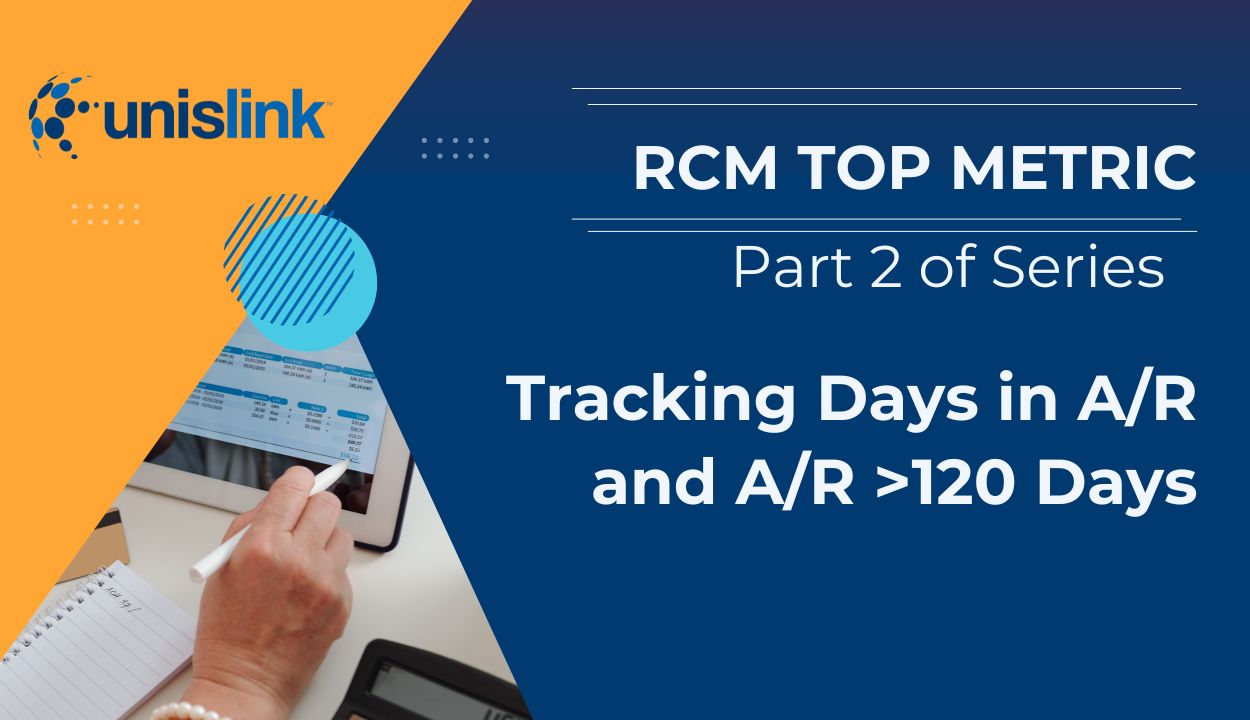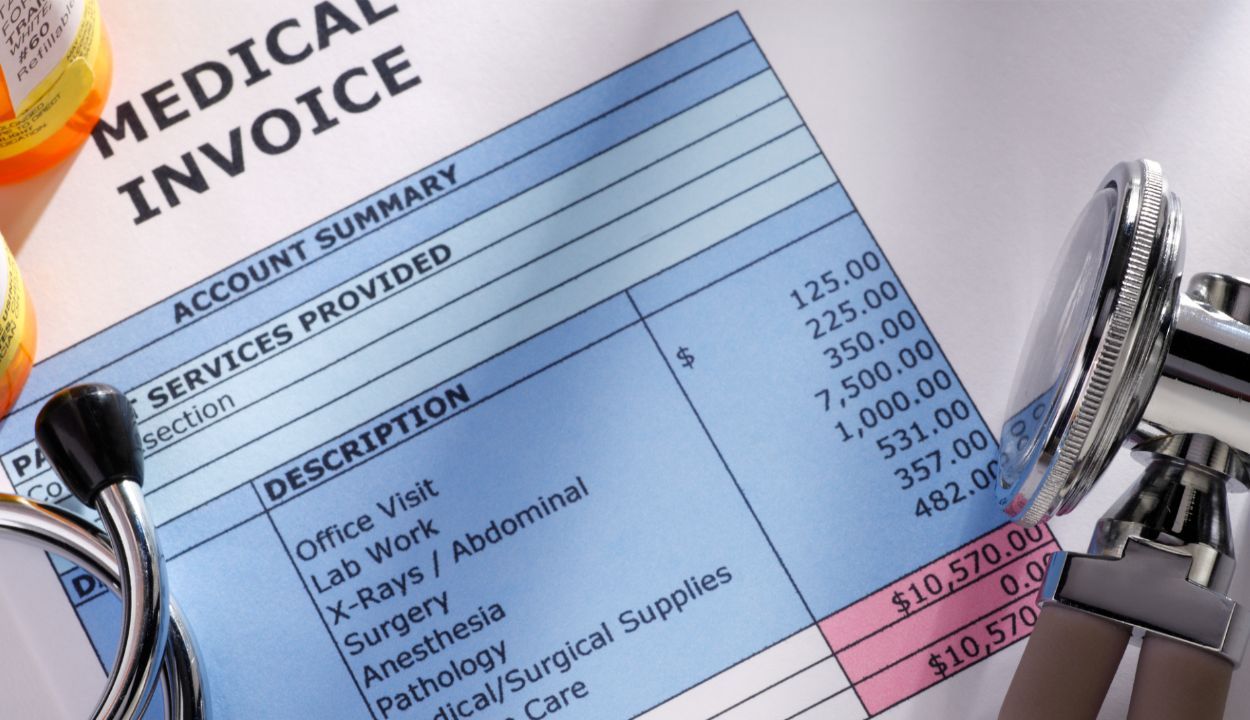This article, Tracking Days in A/R, is Part 2 in our series on Tracking Top RCM Metrics:
Part 1: Seven Most Important RCM Metrics That Every Medical Practice Should Monitor
Part 3: Why Average Revenue Per Encounter is Important for a Medical Practice
Part 4: How to Calculate Your Denial Rate and Reduce Denied Claims
Part 5: Monitoring Gross Collection Rate, Revenue Realization Rate, and Net Collection Rate
Financial stability is just as important as clinical excellence for any medical practice. Yet many healthcare providers, from small and mid-sized groups, to large healthcare organizations, struggle to maintain healthy cash flow. The main problem comes down to not collecting earned revenue efficiently.
When revenue is trapped in aging accounts receivable (A/R), it creates a domino effect: tight operating margins, delayed investments in staff and technology, and rising stress levels for practice managers and physicians alike. If your practice is constantly waiting on payments or chasing down old balances, it’s a sign that your revenue cycle and net collection rate needs attention.
The Two Most Important KPIs to Monitor for Healthy A/R
Two of the most critical metrics for any healthcare practice to monitor are Days in A/R and A/R Over 120 Days. These key performance indicators (KPIs) serve as early warning signs for underlying billing and collections issues, offering clear targets for improvement.
Monitoring and improving these two critical A/R metrics is one of the most effective ways for a healthcare practice protect its financial health and improve operational efficiency.
In this post, we’ll break down what each metric means for a medical practice and cash flow, how to calculate it, what causes the numbers to climb, and—most importantly—how to fix it.
1. KPI: Days in A/R
What It Measures
Days in A/R tells you how long it takes, on average, to collect payment after a service is rendered. In simpler terms, it tracks the speed of the collections process and at what pace your money comes in. The higher the number, the longer you’re waiting to get paid, and the tighter your cash flow. A lower number can indicate a healthy cash flow.
Why It Matters
When Days in A/R is high, it signals that revenue is sitting idle. That could mean delayed claim submissions, slow follow-up on claim denials, high denial rate, or patient collection processes that need improvement. Each day a healthcare provider delays collection is a day you could be reinvesting in staff, technology, or patient care.
Efficient practices aim for a Days in A/R under 40. Best-in-class performers are in the 28–32 day range. If your number is above 40, it’s a warning sign that your revenue cycle and billing operation may be underperforming, with good opportunity to improve your financial health.
Formula: Days in A/R
Total Accounts Receivable ÷ Average Daily Charges
Step-by-step:
Step 1: Calculate your Total Receivables, minus any credits or refunds owed.
Step 2: Determine your Average Daily Charges by dividing your total gross charges over the last 12 months by 365.
Step 3: Divide Step 1 by Step 2.
Example:
Total Annual Charges: $18,000,000
Total A/R: $2,000,000
Average Daily Charges: $49,000
Days in A/R = $2,000,000 ÷ $49,000 = 41 days
Reducing Days in A/R to 31 days (an improvement of 10 days) would unlock $490,000 in accelerated cash—the equivalent of getting 10 days of revenue into the clinic faster, and indicative of a healthy cash flow.
Example Clinic Operational Problems That May be Causing High Days in A/R
- Delayed claim submission: If claims aren’t submitted daily, your healthy cash collection is delayed from the start.
- Frequent claim rejections or denials by health insurance companies: Coding errors, missing documentation, or patient eligibility issues can cause delays in payment.
- Slow internal processes: Manual workflows and lack of automation prevent the team from submitting claims in a timely manner, increasing the volume of delayed or unpaid claims.
- Inadequate follow-up: If your revenue cycle team is not routinely checking the status of outstanding claims, they could slip through the cracks.
- Patient balance collection lags: Co-pays and deductibles not collected by your team at the time of service can increase aging A/R, and impact financial performance.
How to Fix High Days in A/R
- Automate and standardize claims submission for insurance companies to go out within 24 hours of service.
- Perform regular audits of your medical coding and visit documentation practices to reduce claim denials.
- Consider outsourcing follow-up processes to an revenue cycle partner with scalable, tech-driven solutions that offer data-driven decisions.
- Collect patient balances at check-in, using real-time insurance verification and payment tools.
- Segment your A/R by payer and aging bucket, so you can prioritize the highest-value opportunities.
2. A/R Over 120 Days
What It Measures
This KPI tracks the percentage of a healthcare provider’s total accounts receivable that is more than 120 days old. A/R Over 120 days is a great metric that shines a light on the most problematic parts of your revenue cycle.
Why It Matters
When unpaid claims stall for more than 120 days, the likelihood of collecting that money drops significantly. That’s true for both insurance payer-side delays and patient balances. This key performance indicator often signals deeper problems, like claim denial management, or a consistent lack of claim denial follow-up, or perhaps an inefficient patient collections process.
The industry benchmark for health providers is 15–20% of A/R over 120 days. High-performing practices aim for 10–15%. If your number is above 30%, it’s a red flag for operational efficiency.
Formula: A/R Over 120 Days
Dollar Value of A/R > 120 Days ÷ Total A/R Value
Example:
Total Receivables: $2,500,000
A/R Over 120 Days: $1,300,000
A/R >120 Days = $1,300,000 ÷ $2,500,000 = 52%
That means more than half your receivables are aged past 120 days, well above industry norms.
Potential Operational Concerns That May Cause High A/R Over 120
- Claim denials aren’t appealed in time: insurance companies have short appeal windows. Delay too long, and you may lose the right to collect.
- Not monitoring A/R segmentation: If you’re not separating patient vs. insurance payer responsibility, or organizing A/R by aging buckets, it’s harder to take targeted action.
- Lack of early patient engagement: patients forget they owe money if there’s a delay in receiving bills or lack of follow-up reminder.
- Outdated contact information: If you’re trying to reach patients with wrong info, bills go unpaid. Get their profile information updated before the visit.
- Staffing limitations: Smaller billing teams may be too busy managing day-to-day tasks to focus on old A/R.
- Lack of qualified staffing: high turnover rates and labor shortages may contribute to revenue cycle teams that aren’t trained or managed in a way to efficiently track A/R.
How to Fix High A/R Over 120
- Segment your A/R by aging category (e.g., 0–30, 31–60, 61–90, 91–120, 120+) and by responsibility (individual payer vs. patient).
- Build a denial management process in the revenue cycle team that includes same-week appeals.
- Use early-out collection strategies: Begin patient outreach as soon as it becomes their responsibility, not after 60 or 90 days.
- Leverage automated reminders, text messages, email, and digital payment portals to make it easy for patients to pay.
- Outsource with a medical billing partner that tracks A/R performance weekly and allocates staff accordingly.
The Connection Between Days in A/R and A/R Over 120
These two key performance indicators regarding accounts receivable are closely related. High Days in A/R is often a precursor to growing A/R over 120 days. If you’re not collecting efficiently in the early stages of the revenue cycle, balances can age, and recovery becomes less likely. Conversely, improving early claims submission and denial management will lower both numbers.
Using KPIs on A/R to Make Data-Driven Decisions
Use information on A/R data and pair it with these additional Top 7 RCM Metrics to create a powerful, high-performing RCM operation.
- Average Revenue per Encounter
- Denial Rate
- Gross Collection Rate
- Revenue Realization Rate
- Net Collection Rate
Together, these indicators give you a comprehensive view of the financial health of your healthcare organization—and the roadmap to improvement.
Partner with Unislink, a highly rated Medical Billing Company, to Improve Your A/R for Speedier Cash Flow
At UnisLink, we specialize in end-to-end revenue cycle management for health providers, giving full visibility into key performance indicators, while actively working to improve them. Whether you need help managing patient balances, reducing claim denials, or getting a handle on your A/R backlog, UnisLink gives you the tools, tech, and team to improve operational efficiency.
Here’s How We Help You Reduce Days in A/R and Shrink A/R Over 120 Days:
- Faster Claims Processing: Our technology ensures accurate claims submission within 24 hours of the patient encounter.
- Advanced Denial Management: We don’t just track claim denials—we fix the root causes, appeal quickly, and prevent them from happening again.
- Patient Engagement Tools: Our platform includes AI-driven digital payment reminders that support text, email, paper statements, phone, and a secure online payment portal.
- A/R Analytics Dashboards: Know exactly where your money is and where it’s getting stuck. We break down A/R by payer, patient, age, and more.
- Dedicated Billing Experts: Our certified coding and billing teams actively follow up on old accounts so you don’t lose hard-earned revenue.
Schedule a consultation with our expert RCM consultants and learn how our revenue cycle management services can streamline your billing process, reduce delays, and unlock the cash flow you deserve.

